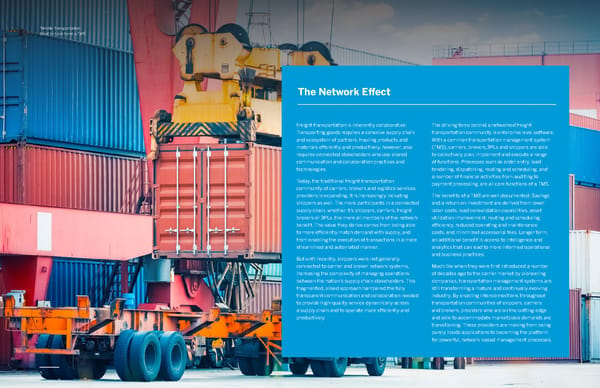5 Trimble Transportation What to Look for in a TMS The Network Effect Freight transportation is inherently collaborative. Transporting goods requires a cohesive supply chain and ecosystem of partners. Hauling products and materials efficiently and productively, however, also requires connected stakeholders who use shared communication and collaboration practices and technologies. Today, the traditional freight transportation community of carriers, brokers and logistics services providers is expanding. It is increasingly including shippers as well. The more participants in a connected supply chain, whether it’s shippers, carriers, freight brokers or 3PLs, the more all members of the network benefit. The value they derive comes from being able to more efficiently match demand with supply, and from enabling the execution of transactions in a more streamlined and automated manner. But until recently, shippers were not generally connected to carrier and broker network systems, increasing the complexity of managing operations between the nation’s supply chain stakeholders. This fragmented, siloed approach hampered the fully transparent communication and collaboration needed to provide high-quality service dynamically across a supply chain and to operate more efficiently and productively. The driving force behind a networked freight transportation community is enterprise level software. With a common transportation management system (TMS), carriers, brokers,3PLs and shippers are able to collectively plan, implement and execute a range of functions. Processes such as order entry, load tendering, dispatching, routing and scheduling, and a number of financial activities from auditing to payment processing, are all core functions of a TMS. The benefits of a TMS are well documented. Savings and a return on investment are derived from lower labor costs, load consolidation capabilities, asset utilization improvement, routing and scheduling efficiency, reduced operating and maintenance costs, and minimized accessorial fees. Longer term, an additional benefit is access to intelligence and analytics that can lead to more informed operational and business practices. Much like when they were first introduced a number of decades ago to the carrier market by pioneering companies, transportation management systems are still transforming a mature and continually evolving industry. By enabling interconnections throughout transportation communities of shippers, carriers and brokers, providers who are on the cutting-edge and able to accommodate marketplace demands are transitioning. These providers are moving from being purely inside applications to becoming the platform for powerful, network-based management processes. 5 Trimble Transportation What to Look for in a TMS
 What to Look for in a TMS Page 4 Page 6
What to Look for in a TMS Page 4 Page 6